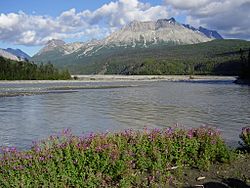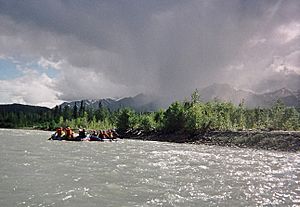Tatshenshini River facts for kids
Quick facts for kids Tatshenshini River |
|
|---|---|

O'Connor Creek delta in the Tatshenshini River in British Columbia
|
|
| Country | Canada |
| Physical characteristics | |
| Main source | DatlasakaCreek 910 m (2,990 ft) 59°50′30″N 136°39′38″W / 59.84167°N 136.66066°W |
| River mouth | Alsek River 120 m (390 ft) 59°28′44″N 137°45′56″W / 59.47894°N 137.76555°W |
The Tatshenshini River is a beautiful river found in the wild forests of southwestern Yukon and northwestern British Columbia, Canada. Its name comes from the Tlingit language (Tʼachanshahéeni) and Southern Tutchone (Shäwshe Chù).
The river starts in British Columbia, close to the Haines Highway. It flows north into Yukon, then turns west and south. It eventually returns to British Columbia, where it runs through the amazing Tatshenshini-Alsek Provincial Park. Here, it joins the Alsek River, which then flows all the way to the Pacific Ocean in Alaska, United States. The Tatshenshini River is a very popular spot for exciting wilderness rafting trips.
Contents
River History: A Path for People
The Tatshenshini River has always been important. Long ago, it was a key trade route for First Nations people, especially the coastal Tlingit tribe. They used the river to travel and trade goods.
Early Explorers and Name Changes
The first Europeans to explore this river were Jack Dalton and Edward Glave in 1890. They had two local guides with them. Before 1891, people thought the Tatshenshini River was actually the upper part of the Alsek River. But around 1891, the Canadian government officially named this river the Tatshenshini. This helped clear up confusion about the different rivers in the area.
Dalton's Trading Post and Gold Rush Days
Around 1897, Jack Dalton set up a trading post near where the Tatshenshini River starts flowing west. This post became very busy during the Klondike Gold Rush, a time when many people rushed to find gold. Today, this old trading post site is a favorite spot for people who love to fish for salmon. It's also where many rafting trips on the Tatshenshini River begin. In 2004, the Tatshenshini River was recognized as a Canadian Heritage River, which means it's a very special river in Canada.
Understanding the River's Name
The name Tatshenshini has an interesting story. Before 1891, this name actually referred to a different river, the Blanchard River. The Blanchard River is a smaller river that flows into the Tatshenshini.
How the Name Tatshenshini Came to Be
In 1891, the Canadian government decided to move the name Tatshenshini from the Blanchard River to the river we know by that name today. It seems they did this without knowing what the name truly meant in the Tlingit language.
The name Tatshenshini comes from a Tlingit phrase: t’áchán shahéeni. This phrase means "river with stinking chinook (king) salmon at its headwaters." Let's break it down:
- t’á means 'chinook or king salmon'
- chán means 'stink'
- sha means 'head of'
- héen means 'river'
Why the Name Makes Sense
This Tlingit name perfectly describes the Blanchard River, which was the original "Tatshenshini." Chinook salmon swim up the Tatshenshini River and then into the Blanchard River. They go all the way to the very start, or "headwaters," of the Blanchard River. There, the salmon die after laying their eggs, and their bodies can create a strong smell. These headwaters were also along an old Tlingit trail and trade route, known as the Dalton Trail, which connected Haines, Alaska to Lake Kusawa in Yukon.


